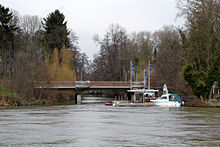Kinzig (Main)
| Kinzig | |
|---|---|
Sterbfritz | |
| • coordinates | 50°18′13″N 9°37′11″E / 50.303479°N 9.619721°E |
| • elevation | 400 m above sea level (NN) |
| Mouth | |
• location | West of the Altstadt of Hanau into the Main at river kilometre 55 |
• coordinates | 50°07′46″N 8°54′08″E / 50.129534°N 8.90222°E |
• elevation | 99 m above sea level (NN) |
| Length | 87.2 km (54.2 mi) [1] |
| Basin size | 1,058 km2 (408 sq mi) [1] |
| Discharge | |
| • location | [2][3] at its mouth |
| • average | 10.97 m³/s |
| Basin features | |
| Progression | |
| Waterbodies | Reservoirs: Kinzig-Stausee |
| Navigable | No (in the Middle Ages from Gelnhausen to its mouth) |
 Mouth in Hanau | |
The Kinzig is a river, 87 kilometres long, in southern Hesse, Germany. It is a right tributary of the Main. Its source is in the Spessart hills at Sterbfritz, near Schlüchtern. The Kinzig flows into the Main in Hanau. The Main-Kinzig-Kreis (district) was named after the river. The towns along the Kinzig are Schlüchtern, Steinau an der Straße, Bad Soden-Salmünster, Gelnhausen, and Hanau. The Kinzig is first recorded in 815 A.D. as Chinzicha.
This river played a part in the Battle of Hanau in October 1813, as Napoleon retreated back to the Rhine, after his defeat at the Battle of Leipzig.
There are several German rivers called Kinzig. Another Kinzig flows into the Rhine in Kehl-Auenheim
Geography
Sources
The source of the Kinzig (Kinzigquelle) is located at a height of about 400 m above , that has an outflow pipe. The headstream that rises here flows for a few metres towards the northwest where it unites with a longer headstream.
Course

From its source, the Kinzig runs northwest and forms the boundary between the
Places on the Kinzig
(in downstream order)
- Sterbfritz(source)
- Sannerz
- Vollmerz
- Herolz
- Schlüchtern
- Niederzell
- Steinau an der Straße
- Ahl
- Salmünster
- Neudorf
- Wächtersbach
- Wirtheim
- Haitz
- Gelnhausen
- Lieblos
- Rothenbergen
- Langenselbold
- Erlensee
- Niederrodenbach
- Hanau (mouth on the Main)
Tributaries
The Kinzig catchment covers an area of 1,058 square kilometres.[4]
- The most important tributaries (>10 km) are (in downstream order)

References
- ^ a b Water map service of the Hessian Ministry for the Environment, Energy, Agriculture and Consumer Protection (Hessisches Ministerium für Umwelt, Energie, Landwirtschaft und Verbraucherschutz)
- ^ Topographic map, 1:25,000 series and WRRL database
- ^ Pegelwert Hanau vermehrt um den Gebietsabfluss des Resteinzugsgebietes (137,08 km²), ermittelt aus den Daten der Pegel Rück, Hainstadt, Goldbach, Harreshausen, Alzenau, Hanau, Kleinheubach und Frankfurt a.M. Osthafen
- ^ Retentionskataster Flussgebiet Kinzig[permanent dead link]
External links
- Kinzig catchment area (pdf 1.62 MB)
- HLUG-Pegel Hanau
- Water fact file and action programme 2478.1 Untere Kinzig
- Water fact file and action programme 2478.3 Obere Kinzig
- The Kinzig is barrier free: fish may swim unhindered. FR, 7 August 2009, Alexander Polaschek
